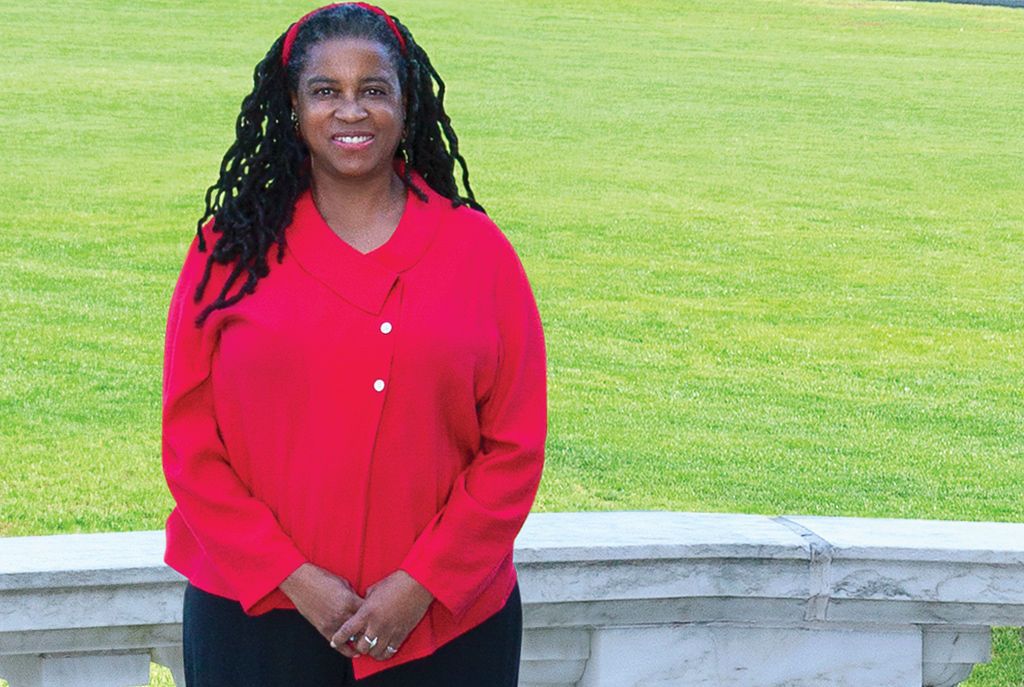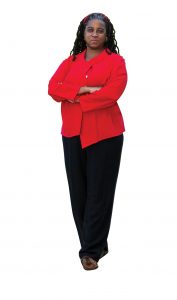Interpreter of Biases

In the battle for left brain/right brain dominance, Alison Williams ’81 may well be a case study in cheerfully riding that middle line. A biophysical chemist and semi-professional oboist, Williams is adept at bridging the gaps between two seemingly opposite ends of the spectrum, a skill that has come in particularly handy as she navigates her role as Wesleyan’s new vice president for equity and inclusion/Title IX officer.
A year into her appointment as Wesleyan’s vice president for equity and inclusion/Title IX officer, Alison Williams finds her days packed with meetings, planning sessions, workshops, and one-on-one consultations dealing with everything from COVID-related visa issues and remote-learning troubles, to cultivating bias awareness across campus, and creating a more equitable experience for all students, faculty, and staff at Wesleyan.
It can be chaotic and unpredictable, but by now balancing the challenges of academic life alongside bigger issues of access and equity is the norm for Williams, who didn’t necessarily plan on leading this charge but found herself on this path as a natural extension of the skills she honed through years of being a Black woman in disciplines traditionally dominated by white men.
Williams was first introduced to Wesleyan in the late ’70s as a high school student in Ohio. “I really was torn about whether I was going to go to music school or study chemistry. And somebody said, ‘Well, you can do both at Wesleyan!’”
She did eventually end up choosing Wesleyan over Princeton (despite the protestations of her guidance counselor), not least because her visits to both universities, just days apart, were so vastly different. At Wes the students had been friendly and welcoming; at Princeton, the tour guide had responded to her dual art and science ambitions with a curt, “You can’t be serious.”
Ironically, later in her career Williams would return to Princeton as a lecturer and associate director of diversity programs, but she never regretted her decision to attend Wesleyan. It was an eye-opening experience for the small-town “faculty brat” and an early lesson in biases—both Williams’s own and the ones others projected on her.
“All of my stereotypes of people of different backgrounds were just blown out of the water. I grew up in a small town, one of four daughters, and even though I was subjected to racism and such, I hadn’t been exposed to the kind of sexism that I actually encountered in the sciences when I was here as a student,” she said. “And I had these preconceived ideas about different groups of people that were just completely wrong. I really appreciate that I met such a varied group of people here. My best friends are still the ones I met at Wesleyan.”
After graduation, chemistry took center stage as Williams pursued advanced degrees and faculty positions in biophysical chemistry, all while continuing to play the oboe and performing in various professional gigs on the side. But she also discovered a third vocation starting to take up a significant portion of her time.
“Being a woman of color in the sciences, I was very used to being dismissed. I have stories upon stories of the kind of sexist and racist comments that faculty and people have said to me over the years. I was also one of the only faculty people of color in the sciences at most institutions where I taught, so students would camp out in my office, and they would tell me stuff and I found that half of what I was doing was saying to them, ‘You can do this,’” Williams remembers. “It was predominantly students of color and first-generation college students, but not exclusively. It could be women, men, students of mine or their friends . . . anybody who felt on the margins in some way, or unsupported or intimidated by my colleagues.”
She found herself pushing students to talk things out with their professors (sometimes literally walking them down the hall and pushing them into the professor’s office) and also coaching her colleagues on speaking to students in a way that exhibited care and compassion. It was a form of bridging the divide that she had become well-versed in from her own dual passions.
“Because I was sort of embedded in the arts and embedded in the sciences, I would hear from both sides their assumptions and their stereotypes of the other. And I was always defending scientists or defending artists. I felt like I learned how to speak different languages just because of the nature of what I was interested in.”
Eventually after 24 years of teaching chemistry in the lab (including a visiting professorship at Wesleyan in the ’90s) and supporting students’ emotional well-being outside the classroom, Williams felt it was time to make a change. “I was ready for a new challenge. While I could impact students individually as a professor, I felt like there needed to be institutional shifts in order to accommodate the students that were coming in.” She took a job at Oberlin as director of a multicultural resource center and an associate provost for diversity, switching over to the administrative side of higher education and eventually finding her way back to Wesleyan as the new vice president for equity and inclusion/Title IX officer.
David Beveridge, the Joshua Boger University Professor of the Sciences and Mathematics, Emeritus, was instrumental in bringing Williams to campus as a visiting professor in the molecular biophysics program in the ’90s. He lauds her return in this new role, noting the valuable contributions that his longtime friend and colleague has made through her hard work and rapport with others. “I am very glad to see Alison back at Wesleyan in a position to make further improvements in affirmative action as well as represent with her inimitable style and grace.”
 Though Williams misses collaborating with students and colleagues in the lab, she finds that the advocacy work she does now indulges a different type of collaboration, one that brings her into contact with people all across campus and at varying levels.
Though Williams misses collaborating with students and colleagues in the lab, she finds that the advocacy work she does now indulges a different type of collaboration, one that brings her into contact with people all across campus and at varying levels.
“Alison is such a committed and humble leader who isn’t afraid to roll up her sleeves and do the work to implement her ideas to meet the community needs,” says Resource Center Director Demetrius Colvin. “She definitely leads by example with her work ethic.”
The problem-solving aspects of the job appeal to Williams’s scientific mind, but the complexities of human nature bring in a more unpredictable element.
“Figuring out how to help people work is very different from figuring out how DNA works—DNA doesn’t talk back! But I work with great people and a great team. It’s important work. It’s challenging, but in a very different way.”
For now, that means speaking across the divide, asking the hard questions, raising awareness, and leading others toward better understanding.
“People have really big struggles in their lives. But how can we make sure those struggles don’t prevent them from being successful? What are the challenges that people of different identities face—be it people of color, be it people with learning differences, be it people from different socio-economic backgrounds? How can we make sure that everyone has the best learning outcomes, the best work experience, regardless of their identity?” she asks. “A lot of what I do is to challenge people’s assumptions about each other across the board—faculty, staff, and students. And to get people to communicate across those differences to understand each other. You don’t have to agree; it’s okay to disagree. But you still have to disagree with respect.”
It’s all in service of her ideal vision for the University: “I try to get people to acknowledge their positionality, their privilege. To empower people to take ownership of and to really go after whatever they’re looking for, especially students,” she says. “I try to cultivate a sense that Wesleyan belongs to all of us, regardless of identity. Because I really believe that.”
Photos by Robert Adam Mayer


